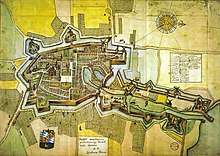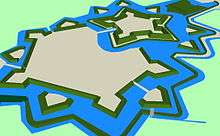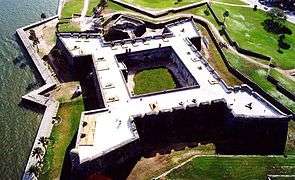Ravelin
A ravelin is a triangular fortification or detached outwork, located in front of the innerworks of a fortress (the curtain walls and bastions). Originally called a demi-lune, after the lunette, the ravelin is placed outside a castle and opposite a fortification curtain.

.jpg)
.jpg)

The outer edges of the ravelin are so configured that it divides an assault force, and guns in the ravelin can fire upon the attacking troops as they approach the curtain. It also impedes besiegers from using their artillery to batter a breach in the curtain wall. The side of the ravelin facing the inner fortifications has at best a low wall, if any, so as not to shelter attacking forces if they have overwhelmed it or the defenders have abandoned it. Frequently ravelins have a ramp or stairs on the curtain-wall side to facilitate the movement of troops and artillery onto the ravelin.
The first example of a ravelin appears in the fortifications of the Italian town of Sarzanello, and dates from 1497. The first ravelins were built of brick, but later, during the sixteenth century in the Netherlands, they were earthen (perhaps faced by stone or brick), the better to absorb the impact of cannonballs. The Italian origins of the system of fortifications (the star forts) of which ravelins were a part gave rise to the term trace Italienne.
The French 17th-century military engineer Vauban made great use of ravelins in his design of fortifications for Louis XIV, and his ideas were still being used in 1761 by Major William Green at Gibraltar.[1]
Gallery
 The ravelin outside the Land Gate at Tilbury Fort
The ravelin outside the Land Gate at Tilbury Fort.jpg) Ravelin Peter (1708) and access bridge, Petersberg Citadel, Erfurt, Germany.
Ravelin Peter (1708) and access bridge, Petersberg Citadel, Erfurt, Germany. Castillo de San Marcos (c.1668), Florida. Ravelin at the top of photo, between two bastions.
Castillo de San Marcos (c.1668), Florida. Ravelin at the top of photo, between two bastions.- Ravelin August-Wilhelm (c.1640), Küstrin Fortress (de), Poland.
See also
- List of established military terms#Engineering
- Raveleijn (Efteling)
References
- Fa & Finlayson (2006). The Fortifications of Gibraltar 1068-1945. Osprey Publishing. p. 25. ISBN 978-1-84603-016-1. Retrieved 30 March 2013.